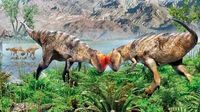In the arid expanse of Mongolia’s Gobi Desert, a team of international paleontologists has unearthed a discovery that’s sending ripples through the scientific community and delighting dinosaur enthusiasts worldwide. On September 17, 2025, researchers from the Institute of Paleontology at the Mongolian Academy of Sciences, working closely with colleagues from North Carolina State University, announced in the journal Nature the identification of a new dinosaur species: Zavacephale rinpoche.
This dinosaur, whose name translates to “dome-headed” and “rare, precious,” stands out not only for its distinctive cranial architecture but also for the exceptional completeness of its fossil remains. According to MONTSAME, the fossil was discovered at the Khuren Dukh formation, a site characterized by Early Cretaceous rocks that are approximately 108 to 115 million years old. The Gobi Desert, already famed for its paleontological treasures, has now yielded what researchers are calling “the most complete specimen of a dome-headed dinosaur ever recorded.”
What makes Zavacephale rinpoche so special? For starters, its fossil includes both the skull and a substantial portion of the postcranial skeleton—shoulder girdle, humerus, vertebrae, pelvis, hind limbs, tail vertebrae encased in ossified tendons, and even gastroliths, or stomach stones. The entire specimen measures about 80 centimeters in length and weighs in at roughly 5.85 kilograms. This level of preservation is exceedingly rare for dome-headed dinosaurs, a group more formally known as pachycephalosaurs, whose fossil record is often limited to fragmentary skull pieces.
According to Mid-day, the specimen represents the oldest and most complete fossil of its kind, dating back to around 108 million years ago. The researchers involved in the project described the find as a “once-in-a-lifetime discovery.” Dr. Ts. Chinzorig, Dr. Kh. Tsogtbaatar, B. Buyantegsh, and B. Mainbayar of the Mongolian Academy of Sciences, along with their North Carolina State University collaborators, led the joint expedition that uncovered the fossil. Their work, published in the high-impact journal Nature, has quickly caught the attention of paleontologists across the globe.
But the intrigue doesn’t stop at the fossil’s completeness or age. The anatomical features of Zavacephale rinpoche are remarkable in their own right. The dinosaur’s dome-shaped, protruding cranial roof is not just a superficial quirk; it’s a defining characteristic of the pachycephalosaur group, which is known for thickened bone domes, horns, and bony knobs atop their heads. While previous discoveries have typically consisted of isolated skull fragments, this specimen preserves enough of the body to give researchers an unprecedented look at the dinosaur’s overall anatomy and lifestyle.
Microscopic studies of the bone tissue, as reported by MONTSAME, confirm that the individual was an adult, despite its relatively small size. However, Mid-day notes that the fossil is of a juvenile dinosaur that already possessed a fully formed head dome—a detail that offers intriguing clues about the development and function of these unique cranial structures.
So, what purpose did these massive domes serve? According to the research team, the answer lies not in defense or temperature regulation, as previously speculated, but in the realm of social behavior. “Researchers said the species used their large head domes for socio-sexual behaviours, such as showing off and competing for mates and not for defending against predators or regulating body temperature,” Mid-day reports. This insight aligns with a growing body of evidence suggesting that many dinosaur features—like the crests of hadrosaurs or the frills of ceratopsians—played key roles in social signaling and mating displays, much like the antlers of modern deer or the plumage of birds.
The discovery of gastroliths within the fossilized remains further enriches our understanding of Zavacephale rinpoche’s lifestyle. Gastroliths, or stomach stones, are often found in herbivorous dinosaurs and are believed to have aided in the digestion of tough plant material. The presence of these stones, along with the dinosaur’s anatomical features, confirms its herbivorous diet.
From a geological perspective, Zavacephale rinpoche represents the earliest known member of the “solid-headed” dinosaur group. Its age and completeness offer a crucial window into the early evolution of pachycephalosaurs, shedding light on how these animals adapted and diversified during the Cretaceous period. As MONTSAME points out, this specimen is not only the first “solid-headed” dinosaur found with forelimb elements and gastroliths but also the most comprehensive example of its kind ever documented.
The significance of this find extends beyond the scientific community. The publication of the research in Nature—a journal with an impact factor of 50, no less—underscores the global importance of the discovery. It’s a testament to the collaborative spirit of modern paleontology, which often brings together experts from around the world to unlock the secrets buried in the earth’s ancient strata.
For Mongolia, a country with a rich tradition of paleontological research, the discovery of Zavacephale rinpoche is a source of national pride. The Khuren Dukh formation, already recognized as a hotspot for dinosaur fossils, now boasts a specimen that will draw further international attention and likely inspire a new generation of scientists.
Meanwhile, for the broader public, the story of Zavacephale rinpoche serves as a vivid reminder of how much remains to be discovered about our planet’s distant past. Each new fossil find not only fills gaps in the evolutionary record but also sparks the imagination, inviting us to picture a world where creatures with dome-shaped heads roamed ancient landscapes, engaging in behaviors that—though separated by millions of years—echo the social rituals of animals today.
As researchers continue to study the specimen and its context, further revelations are sure to follow. For now, though, Zavacephale rinpoche stands as a rare and precious window into the Cretaceous world, a testament to the power of patient exploration and international collaboration in the quest to understand life’s grand history.
